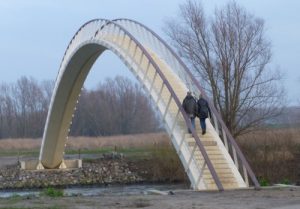02 May National and R.I. Efforts Advocate for Composites in Infrastructure
In April, members of the American Composites Manufacturers Association (ACMA) participated in a hearing before the U.S. House of Representatives Subcommittee on Research and Technology of the Committee on Science, Space, and Technology to advocate for composites as an innovative solution to build and repair our nation’s infrastructure.
Dr. Joannie Chin, Deputy Director of the Engineering Laboratory at the National Institute of Standards and Technology (NIST), summed up the benefits of composites and the barriers to their wider adoption in infrastructure in her remarks: “Many owners and design professionals don’t yet have enough confidence in the reliability and long-term durability of advanced composites to specify their use in new [infrastructure] structures, as well as to repair damaged ones,” she stated. Additionally, she continued, designers and engineers need data and design guidance so they can provide proper safety margins while maximizing the weight and cost savings of composites.
In 2017, ACMA and NIST facilitated a workshop that included members of industry and academia, as well as end users, to create a road map for overcoming these barriers. You can read their special report here.
You can also listen to the hearing at the U.S. House of Representatives here.
The Composites Alliance of Rhode Island and its Infrastructure Working Group have been working in a parallel fashion to address the same issues on a state level. That has entailed meeting with stakeholders to define the problem and developing relationships with industry and organizations including the R.I. Department of Transportation (RIDOT), University of Rhode Island, and policymakers such as Senator Whitehouse and his staff to chart a path to solutions.
A research study by engineering graduate students at the University of Rhode Island–done in coordination with the Composites Alliance, Rhode Island Foundation, and the R.I. Commerce Corporation—constitutes the first phase of research.
URI graduate students have already presented their detailed report including case studies on pedestrian and highway bridges around the world built primarily with composite materials instead of steel and concrete. Some 40 government, research and industry leaders attended the presentation, including Rhode Island DOT Director Peter Alviti Jr., R.I. Turnpike & Bridge Authority Executive Director Buddy Croft, and members of the Composites Alliance and Rhode Island Commerce Corp.
A second phase of research beyond this literature review is in the process of being defined by the Composites Alliance and its Working Group. RIDOT has also already identified several pedestrian bridges as candidates for using composites.
To both change the perception of composites as an infrastructure solution and to collect the data designers and engineers need to utilize the materials and building methods is not something that will happen overnight. But gradual progress is being made on both the national and the Rhode Island fronts.
The Composites Alliance will keep its members and followers updated as more progress is made.

